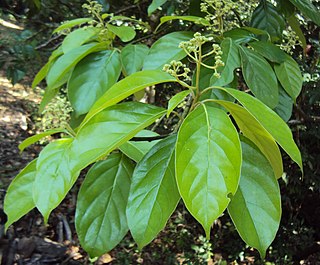The South Western Ghats montane rain forests are an ecoregion of southern India, covering the southern portion of the Western Ghats range in Karnataka, Kerala and Tamil Nadu, at elevations over 1000 meters. They are cooler and wetter than the lower-elevation South Western Ghats moist deciduous forests, which surround the montane rain forests.

Sharavati is a river which originates and flows entirely within the state of Karnataka in India. It is one of the few westward flowing rivers of India and a major part of the river basin lies in the Western Ghats. The famous Jog Falls, located about 24 km from Sagara, are formed by this river. The river itself and the region around it are rich in biodiversity and are home to many rare species of flora and fauna.

The Malabar large-spotted civet, also known as the Malabar civet, is a viverrid endemic to the Western Ghats of India. It is listed as Critically Endangered on the IUCN Red List as the population is estimated to number fewer than 250 mature individuals, with no subpopulation greater than 50 individuals. In the early 1990s, isolated populations still survived in less disturbed areas of South Malabar but were seriously threatened by habitat destruction and hunting outside protected areas.
The term Malabar rainforests refers to one or more distinct ecoregions recognized by biogeographers:
- the Malabar Coast moist forests formerly occupied the coastal zone to the 250 metre elevation
- the South Western Ghats moist deciduous forests grow at intermediate elevations
- the South Western Ghats montane rain forests cover the areas above 1000 metres elevation

Nagarhole National Park, is a national park located in Kodagu district and Mysore district in Karnataka, India. It is one of India's premier Tiger Reserves along with the adjoining Bandipur Tiger Reserve.

Draco dussumieri or southern flying lizard, is a species of agamid lizard capable of gliding from tree to tree. It is found in the Western Ghats and hill forests of southern India. They are almost completely arboreal, found on trees in forests and adjoining palm plantations where they climb trees to forage for insects and glide to adjoining trees by expanding the patagium, loose skin on the sides of the body which are supported by elongated ribs to act as wings. The skin on the sides of the neck are also extended to the sides using the hyoid bones of the tongue to support them. During the breeding season males maintain small territories which they defend from other males while courting females. Males have a more colourful patagium than females and they prominently extend their yellow dewlaps forward in display. Although living almost their entire lives on the trees, females descend to the ground to lay eggs in soil. This is the species with the western most distribution within the genus Draco, the majority of species occurring in Southeast Asia.

Otocryptis beddomii, commonly known as the Indian kangaroo lizard, is a diurnal, terrestrial, insectivorous agamid lizard, endemic to the Western Ghats of South India.

The stripe-necked mongoose is a species of mongoose found in southern India to Sri Lanka.
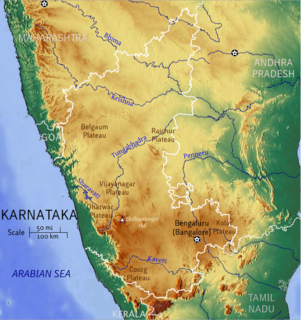
Bayaluseeme or Bayalu Seeme is the area lying to the east of Malenadu, a region of Karnataka state in India. The area is largely open plain, with few hillocks. It includes the districts of Bangalore, Bagalkot, Bijapur, Chitradurga, Davanagere, Dharwad, Gadag, Hassan, Haveri, Mandya, Mysore, Tumkur, the eastern edge of Uttara Kannada.

Sacred groves of India are forest fragments of varying sizes, which are communally protected, and which usually have a significant religious connotation for the protecting community. Hunting and logging are usually strictly prohibited within these patches. Other forms of forest usage like honey collection and deadwood collection are sometimes allowed on a sustainable basis. Sacred groves did not enjoy protection via federal legislation in India. Some NGOs work with local villagers to protect such groves. Traditionally, and in some cases even today, members of the community take turns to protect the grove. However, the introduction of the protected area category community reserves under the Wild Life (Protection) Amendment Act, 2002 has introduced legislation for providing government protection to community held lands, which could include sacred groves.
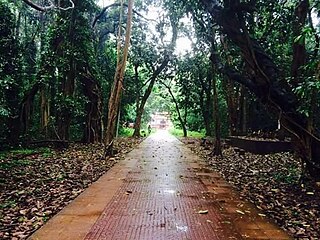
Kavu is the traditional name given for sacred groves across the Malabar Coast in Kerala, South India. Kavus are notable for Theyyam, the centuries-old ritual dance.

The state of Karnataka in South India has a rich diversity of flora and fauna. It has a recorded forest area of 38720 km2 which constitutes 20.19% of the total geographical area of the state. These forests support 25% of the elephant population and 20% of the tiger population of India. Many regions of Karnataka are still unexplored and new species of flora and fauna are still found. The Western Ghats mountains in the western region of Karnataka are a biodiversity hotspot. Two sub-clusters of the Western Ghats, Talacauvery and Kudremukh in Karnataka, are in a tentative list of sites that could be designated as World Heritage Sites by UNESCO. The Bandipur and Nagarahole national parks which fall outside these subclusters were included in the Nilgiri biosphere reserve in 1986, a UNESCO designation. Biligiriranga Hills in Karnataka is a place where Eastern Ghats meets Western Ghats. The state bird and state animal of Karnataka are Indian roller and the Indian elephant respectively. The state tree and state flower are sandalwood and lotus respectively. Karnataka is home to 406+ tigers.
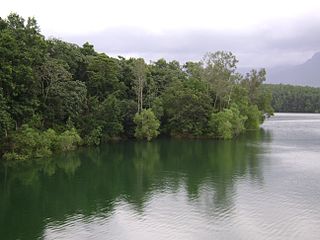
The Peppara Wildlife Sanctuary is a wildlife sanctuary near Thiruvananthapuram in southern Kerala, India. It consists of the catchment area of the Karamana river, which originates from Chemmunjimottai, the tallest hill within the sanctuary. The sanctuary is named after the Peppara dam, commissioned in 1983 to augment the drinking water supply to Thiruvananthapuram city and suburban areas. Considering the ecological significance of the area, it was declared a sanctuary in 1983. The terrain is undulating with elevation ranging from 100 m to 1717 m. The area of the sanctuary is 75 km2 with tropical moist evergreen forests and myristica swamps. Peppara Wildlife Sanctuary is 44 kilometres (27 mi) by car from the nearest railway station, at Thiruvananthapuram, and 49 kilometres (30 mi) from the Thiruvananthapuram airport.

Talakaveri Wildlife Sanctuary is a wildlife sanctuary in Karnataka state of South India. It is located in Kodagu district and is spread over 105 km². It borders with Ranipuram hills and Kottencheri hills in Kasarkod district of Kerala. There is a passage way for jeep from talacauvery to pulingome which is the easiest way from talacauvery to kerala but passengers are not allowed to travel via this way without the permission of forest department.
Biogeographic classification of India is the division of India according to biogeographic characteristics. Biogeography is the study of the distribution of species (biology), organisms, and ecosystems in geographic space and through geological time. There are ten biogeographic zones in India.
- Trans Himalayan zone.
- Himalayan zone
- Desert zone.
- Semiarid zone.
- Western ghat zone.
- Deccan plateau zone.
- Gangetic plain zone.
- North east zone.
- Coastal zone.
- dhanoa zone
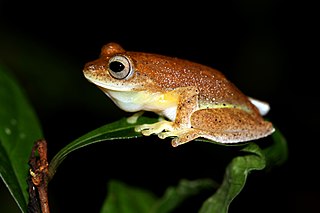
Mercurana is a genus of arboreal frogs belonging to the family Rhacophoridae. The genus was named from the only known species Mercurana myristicapalustris, which was described in 2013 from the Western Ghats of Kerala, India. The generic name was derived from and given as a tribute to Freddie Mercury, the late vocalist of the British rock band Queen, in combination with the Latin name for "frog". The frog is different from other related frogs in that it has extensively webbed toes, lives only in swampy lowlands, and lays its eggs on mud with which it carefully mixes leaf litter.

Calocypha laidlawi, or myristica sapphire, is a rare species of damselfly belonging to the family Chlorocyphidae. It is found only from Karnataka and Kerala in South India.
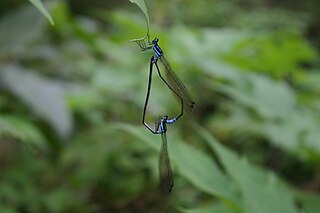
Phylloneura westermanni, Myristica bambootail is a damselfly species in the family Platycnemididae. It is endemic to Myristica swamps of Western Ghats in India. The habitat is restricted to a few localities in Karnataka, Kerala and Tamil Nadu.











